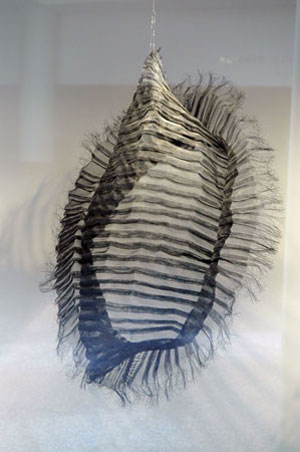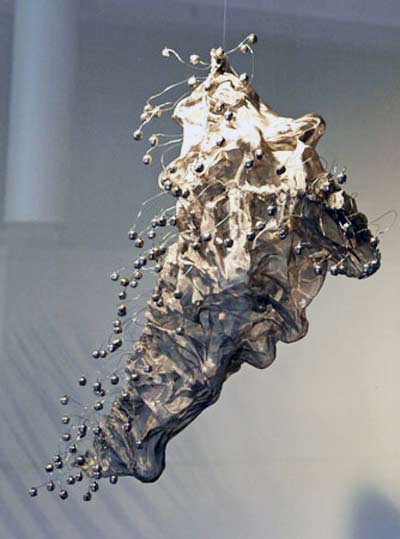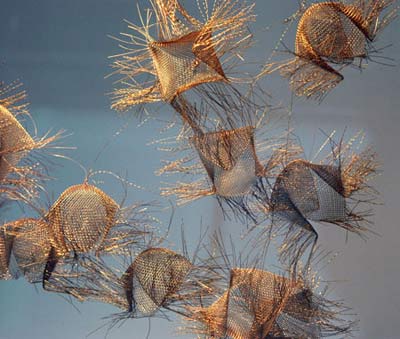
 Sculpture News at SculptSite.com
Sculpture News at SculptSite.com
Atticus Adams Sculpture |
| TribLive / PITTSBURGH TRIBUNE-REVIEW By Kurt Shaw Some unusual things have taken up residence in the lobby of the Steel Plaza T-Station at One Mellon Center, Downtown. Fifteen amoeba-like blobs hover in the windows along the walkway leading to the subway. Not sea creatures per se, they are artworks by a most unusual artist, Atticus Adams, who lives and works in Lawrenceville. The 15 wild wire works make up the show "My Walden." Made of industrial metal mesh that Adams has largely pushed, pulled, cut and stitched into large, fluid sculptures, they float and undulate in space, creating dramatic shadows that are as much a part of the piece as the mesh itself. Some of the works have small bits of glass, scavenged from beaches and broken windshields, that are woven into the sculptures, casting color and reflecting light onto walls and viewers. Adams' intuitive handling of the material guides the organic and philosophical results, allowing the raw materials to provide direction in its reshaping. These ethereal pieces reflect Adams' engagement with process and making. Adams first used the aluminum mesh during an architecture program in 1992. But the material did not become a major focus until 2003, after he was inspired during a sculpture class at Yale. "I loved the inherent beauty of the material with its lightness and malleability," he says. For Adams, this material, with its flat grid of intersecting lines, became representative of his artistic self-reinvention from a conservative, small-town upbringing. "It is a two-dimensional raw material, shapeless but ready to be formed," he says. "One's life can seem the same, and I have been reshaping myself, aspiring to live as an artistic and critical thinker." Born to West Virginia parents while they lived in remote Oregon, Adams' family returned to the mountains of Appalachia when he was a toddler. For practical reasons, creativity was not encouraged except as a hobby. Adams, nonetheless, dabbled in a number of art projects including photography, collage, drama, fashion and multimedia shows. His first college experience culminated in a degree in the health sciences from West Virginia University, but creative exploration continued to be a strong drive. After graduation, Adams continued to survey a broad range of studies -- from drama to architecture -- through programs at the Rhode Island School of Design, Harvard University and the Yale School of Art. At Harvard, after stumbling on some metal screen in a supply closet, Adams began to use it as a component in his student architectural models. After completing his studies, Adams' process to escape from conservative expectations continued, and he led an almost monk-like existence pondering the work of literary thinkers like Thoreau and Whitman. During this long period of transition, he was guided by art, literature, philosophy, friendly influences and a found object -- a broken leg from an antique chair. Through a new group of friends, Adams began to creatively express himself with more purpose. Remembering his earlier use of metal screen and appreciating its malleable qualities, he began to consider it his artistic medium. When the broken chair leg Adams collected as a sculpture component fell into one of his mesh creations, it caused a stretched protrusion. Purposeful use of this chair leg became an early technique of manipulating the material, and in a symbolic gesture, Adams still uses it as one of his few tools. Though not based on any literal organisms or literary references, Adams' intuitive handling of the material guides the organic and philosophical results. He is always playing with the material to discover new techniques and forms. Most of the works in this exhibit are biomorphic in nature, such as "Atalaya" and "Consuelo," which were inspired by cocoons or chrysalis forms. "Theodosia" and "Shaolin" were inspired by multiples found in flowers. "Nature and its beautiful forms provide a welcome creative haven from so much that is difficult and ugly in our world," Adams says. Adams says he sees this exhibit, this body of work, as one installation, with each piece being part of a larger, created environment. "The pieces make sense for me when they are together, as objects from their own world," he says. "I guess they are artifacts -- they provide evidence of something amazing and personal that happened in my life when I moved to Pittsburgh." Adams moved to Pittsburgh in the fall of 2005. He describes his early time here as his "Walden Pond moment." In the spring of 1845 American author, poet, abolitionist and naturalist Henry David Thoreau (1817-62) said, "I went to the woods because I wished to live deliberately, to front only the essential facts of life, and see if I could not learn what it had to teach, and not, when I came to die, discover that I had not lived." Thus, Thoreau began his famous life experiment on the edge of Walden Pond. "Thoreau's experiment has guided me in my life and art," Adams says. "Here, I have been able to simplify, find form in my life, and focus on making art," he says. "This personal process is reflected in my work, where ordinary materials that I find inherently beautiful -- metal mesh, wire, broken auto glass, etc. -- are manipulated with my bare hands and a few simple tools. I experiment to see what I can learn from these materials, as they provide a creative direction of their own. This engages me intuitively in mysteries of the creative process. Joy is the result." |
 What a path of life Atticus Adams has followed. The discoveries along that path are phenomenal in the way he searched and his creations unfolded. His works reflect that journey - they seem to have a purpose beyond their design... Pittsburgh is a great city, lots of creative talent. Thanks to Kurt Shaw for a story well told. |
 "Waccamaw" by Atticus Adams |
 "Jubilee Cloud" by Atticus Adams |
 "The Burrs" by Atticus Adams |
More Sculpture News ....
Submit your SCULPTURE NEWS.
It's easy, just send us an e-mail
(click on Submit News in the left menu) with your pertinent information along with images, we'll take care of the rest. Sculpture makes our world a much better place in so many ways!
SculptSite.com, along with Sculptors and their creative genius all helping to bring the beauty and message of Sculpture to a hurried world.

